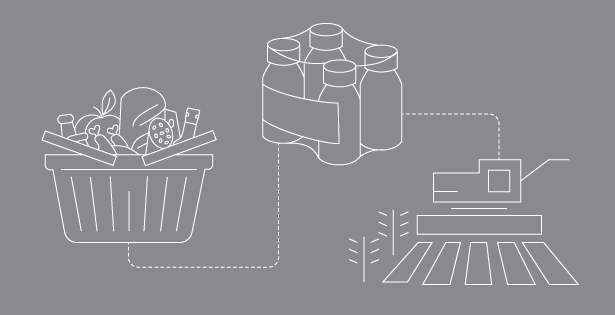Have you ever found yourself evaluating the nutrition or ingredient information on a product’s label while grocery shopping? Whether this is due to health concerns, an increased self, or social consciousness of wanting to know where your food comes from, consumers require more transparency about the ingredients in the finished goods products they purchase. An essential part of delivering the customer experience is helping them understand the product before they buy it.
Products go through various operations before they are produced and ultimately in the consumer’s hands. This process starts with handling your all-important raw materials while spearheading critical issues of food safety and reducing negative consequences in the supply chain with consumers and other manufacturers. Achieving optimum supply chain visibility and inventory traceability requires a centralized system of real-time data and business processes that can capture outcomes from other ancillary instruments, resources, or software. Without a digital quality management solution, identifying nonconforming material and executing corrective actions can become a challenge throughout commodities’ procurement and planning cycles.
Food and Beverage manufacturers encounter multiple quality challenges during raw material receipt, from vendors and harvesters alike, before successfully issuing to production.
Inbound challenges
- There is a potential to register vast information about the product you received or the vendor who supplied it. These detailed item specifications can be easily lost during inventory transactional auditing activities:
- Truck inspections and temperature checks
- Packaging/handling requirements
- Countries of origin
- Manufacturer SKU codes
- Batch details
- Product attributes
- Allergens
- Shelf-life dates
- Label information
- GS1 GDSN codes
- Some products and samples must undergo one or multiple quality tests before they can be fully unloaded or even enter the facility. Testing procedures can be performed with outdated systems and lack coordination, which negatively impacts raw materials that need to be expedited to production and bottleneck dock or quarantine areas.
- Logging quality test results and nonconformance information are often handled by decentralized record systems. These increase the risk of errors needing to trace forwards or backward during a recall.
- Releasing products from quality hold can be time-consuming and become labor intensive, adversely affecting downstream material handling efficiency and the velocity of available inventory for production demand.
- Warehouses often lack proper visibility and stock controls of date-sensitive inventory.
- In some circumstances, the product may have already entered production before an issue has been identified by you or your suppliers.
- Timely notification that products do not adhere to the agreed specifications can lead to poor vendor management. This can result in the continuous need to test the product more frequently, reject deliveries, or return for replacement, negatively affecting the time and expenses to do so.
How can Enterprise Resource Planning (ERP) help?
In today’s ERP systems, there is a wide range of standard user functions and integration strategies to technology that can evaluate the inbound product. Combining these tools with BI (Business Intelligence) and data analytics from a single system maximizes quality assurance and helps securely drive more real-time decision-making in managing your ingredients.
A modern, centralized ERP system at the receipt and beyond enables manufacturers to effectively sample products, perform tests, and capture results for an acceptable quality level or threshold. You will employ a more effective, integrated tracing process against nonconforming material, which can output real-time alerts, detailed correction actions, and stakeholder notification tasks. Quality control can also be initiated automatically based on predefined criteria like a specific vendor or item. ERP will continuously evaluate your quality attributes in inventory, allowing you to block it and prevent cross-contamination between other stocked items, better optimizing material usage and realizing production impacts. Manufacturers can hold themselves accountable for the caliber of raw materials issued to production and the sequence in which they are supplied.
What does the future hold?
As consumer demand continues to evolve, so do the requirements to know where our ingredients are coming from and how they are handled in the meantime. Manufacturers are looking for IT solutions that allow them to receive materials more innovative and more responsive to quality events than ever before. It is essential to deploy ERP with a fully integrated quality management system, starting at the beginning of your supply chain.
Vendors are supplying more detailed product information at the point of receipt. We can start by seizing that opportunity to capture those attributes quickly using GS1 barcode parsing capabilities in warehouse management. Functions like this limit the need for additional user intervention and assist in efficient downstream tracing processes. Emerging technologies with IoT (Internet of Things) can assist in deploying quality tasks automatically and strategically, ensure every lot meets your quality specifications, and limit the need for frequent retesting or unnecessarily putting raw materials on hold.
There are future possibilities to deploy AI (Artificial Intelligence) and Machine Learning applications to specific points of your supply chain process. For example, a quality model incorporating Machine Learning might identify an awful lot because of prior issues with a vendor or the time of year it was procured. By leveraging these statistical algorithms, predictive analytics can help limit situations where you must react to quality issues as they take place. Furthermore, you can begin forecasting the probability of these issues before additional time, money, or resources are wasted.
Start looking to deliver your organization with a single source of truth that customers require and regulators expect.
Additional reading
Read the following for more insights around this topic:
RSM understands Quality Management challenges in the Food and Beverage (F&B) Industry – Part #2
Please contact us here if you have any questions or visit our website to learn more.

 RSMUS.com
RSMUS.com

